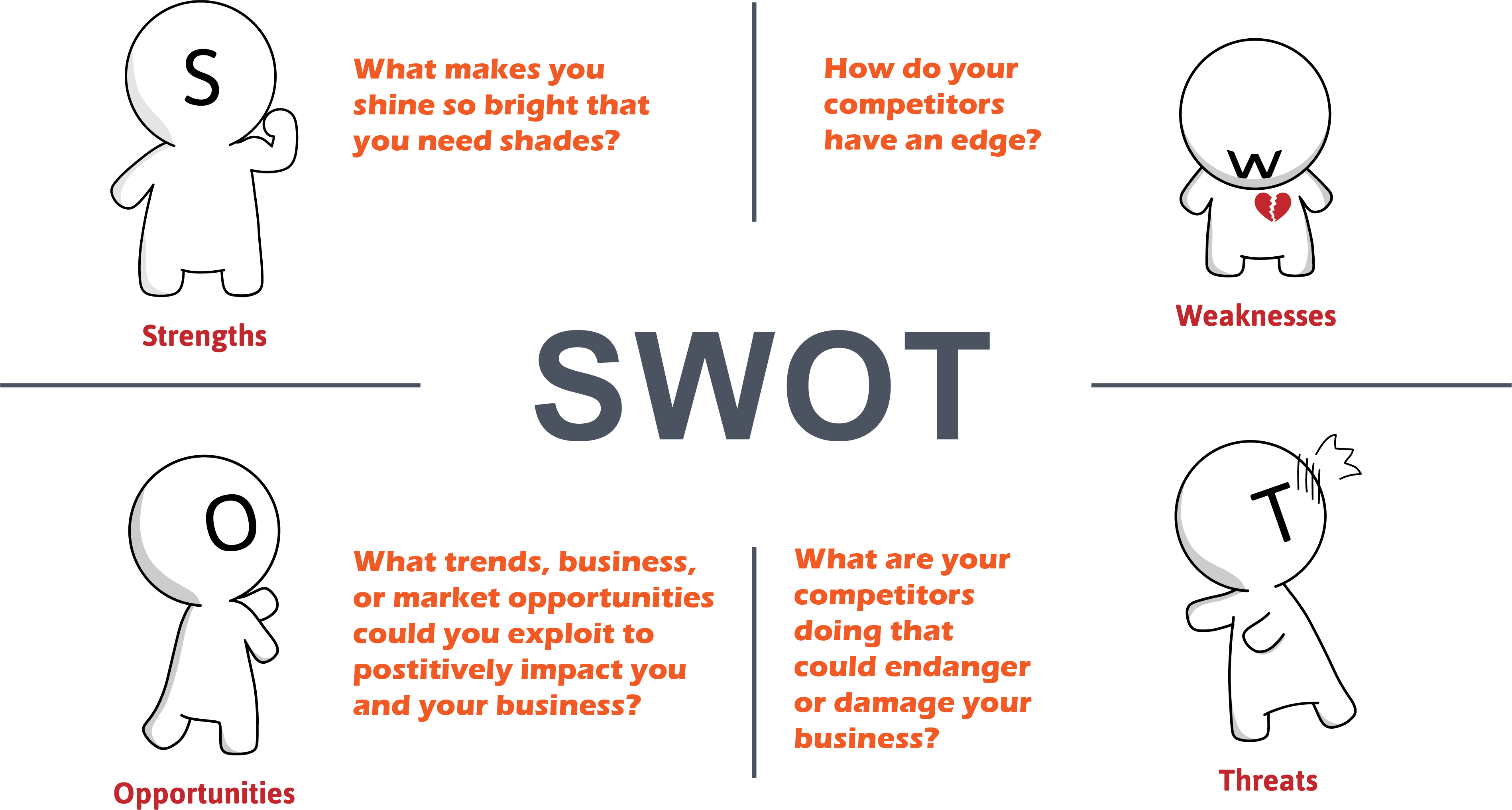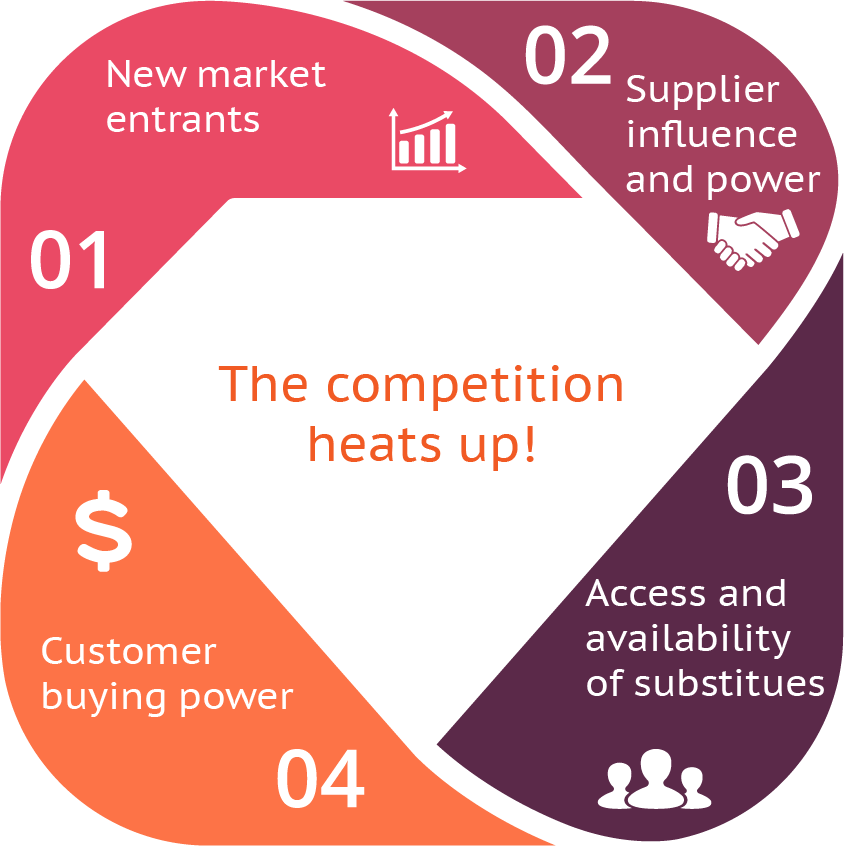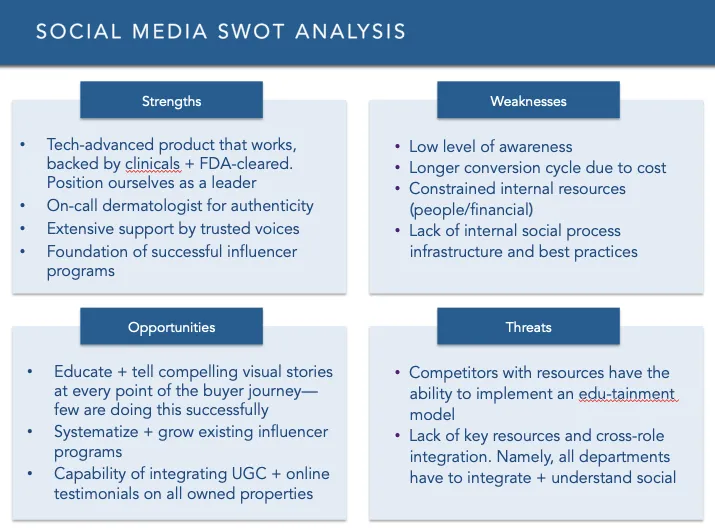Assessing the strengths, weaknesses, opportunities, and threats is an essential process for any brand.
SWOT analysis 🔗
Be honest. How are you helping your brand and how are you hurting it? Are you comfortably uncomfortable or are you looking to make a seismic shift? Is your ego holding you back or is your perspective calculated enough to be objective? Or does your business remind you of Sisyphus: every day, you push a boulder up a hill only to have it tumble down and make roadkill of your face? Maybe it’s time to bring in the SWOT.
It forces you to be brutally honest about where you are today and the possibilities that lie ahead, laying the foundation for brand and business strategies and goal-setting. SWOTs are agile because they can be applied to any aspect of your product, brand, or business — as long as they align with your overall brand or business goals.

- Strengths: What are you good at? What makes you shine so bright you need aviator shades? What unique skill sets put you at an advantage? What do others (e.g., customers, partners, vendors, competition, etc.) think you’re good at?
- Weaknesses: What are your weaknesses? Where do your competitors have an edge? What do others perceive as your vulnerabilities or disadvantages?
- Opportunities: What trends, business, or market opportunities could you exploit to positively impact you and your business? Is there a geographic opportunity? A more affordable vendor or acquisition candidate?
- Threats: What are your competitors doing that could endanger or damage your business? Who or what are the environmental troublemakers? What requires your immediate attention? For example, do you have enough funding or cash flow? What impact does your weaknesses have on your threats (they’re often inextricably bound to one another)?
Similar to the brand discovery process, in a SWOT analysis, we prioritize the evaluation of external elements, such as opportunities and threats, through PEST analysis, market frameworks, and methodologies (such as Michael Porter’s Five Forces Framework) because outside mitigating forces have a direct impact on the internal analysis of your company’s strengths and weaknesses. You have immediate influence and control over the inner workings of your company, but when you turn your lens outward, your influence has less of a direct impact. There are factors outside your control that can’t easily or quickly be changed to your advantage.
In order to get a holistic view of your business, you should assess and evaluate the internal factors independently of the external — and then bring all the pieces together in a final SWOT analysis.
You’re probably wondering how to determine what elements comprise each quadrant. I’d recommend sitting down with key team members to map out the good, the bad, and the ugly in the form of short bullet points. This exercise is not about creating a magnum opus, but rather, you want to inventory all the factors that could influence your business. Below are some brainstormed ideas of things you could include to give the process focus and direction.
Internal evaluating factors 🔗
- Core competencies, skills, talents, expertise, and experience
- Product portfolio and pipeline development
- Point of parity relative to the competition, i.e., are you missing a function, feature, or trait that is endemic of the industry?
- Point of difference, i.e., what’s your competitive advantage? What sets you apart from the competition?
- Proprietary information, patents, and trademarks
- Value, price, utility, quality, geographic advantages
- Key assets in the form of talent, technology, research and development, or financials
- Substantiators in the form of accreditations, awards, testimonials, and brand or science-backed research
- Sales and marketing prowess
- Customer service, care, and management
- Operational and systems efficiency/efficacy
- Vision, mission, beliefs, and value system
- Company culture, organizational structure, and management
External evaluating factors 🔗
- Social, economic (macro and micro), and political climate
- Pricing regulations or market-driven pricing
- Government or industry rules and regulations
- Points of supply and distribution
- Market and product trends and innovations
- Customer trends and behavior
- Technological shifts and advancements
- Competitor business and brand practices, advantages, and disadvantages (also, consider “Blue Ocean” entrants — competitors that have carved out a part of your industry and redefined their business formulation and structure)
To burrow deep on some of these external factors as part of the overall SWOT analysis, I’ll share two methodologies that are graphic representations of complex, multilayered systems. But know that there are a variety of methods and approaches to this process. I’m a big fan of the PEST (or PESTLE) and the Five Forces Framework. Each business and its customers, market, and climate will determine which model makes sense for them.
PEST analysis 🔗
A PEST (an acronym for “political, economic, sociocultural, and technological”) analysis observes how and which external factors could impact your business within a given timeframe. These are environmental elements that could either impede growth or serve as strategic opportunities. PEST analysis helps you gauge the health and growth potential of a particular industry and contextualize how your company could be primed for growth or decline. Consider PEST a perfect pregame exercise for your SWOT analysis.
- Political factors could include rules, regulations, and legislation in your country (or countries) of operation that govern how your company must function. Examples include tax policy, employment laws, environmental/ecological regulations, regulatory bodies and associated requirements and certifications, domestic and global trade policies, political conflict and war, and lobbyist groups.
- Economic elements affect your customers’ buying power and your cost of capital. Examples include domestic and foreign economies and exchanges, business cyclicality or seasonality (e.g., customers usually purchase snowblowers right before or during winter), industry and product-specific tax policies, supplier and distribution health and trends, import/export tariffs, etc.
- Sociocultural components are those most closely associated with your audience; they outline the demographic, behavioral, and cultural trends and conditions within a period of time. Examples include consumer attitudes, perceptions, and opinions; a shift in customer motivation and purchase behavior, ethics, religious, personal values, and belief systems; the impact of influencers (i.e., celebrities, editors, media, social media starts, etc.); generational and population growth rate and trends; lifestyle preferences; etc.
- Technological factors make product access and adoption easy or difficult; they’re the ways technology can impact all aspects of your business from idea concept to manufacturing, distribution, marketing, and customer care. Examples include automation and efficiency, research and development investment, innovation, shifts in technology use and adoption, patents and intellectual property (IP), etc.
This excellent tutorial distills complicated information in a simple, easy-to-understand way.
🎥 PESTEL Analysis EXPLAINED | Video (9:48 minutes)
The Five Forces Framework 🔗
In 1979, Michael Porter developed this methodology when he posited that five key competitive forces influence the strength and position of a company, as well as provide insight on a company’s SWOT so they can dodge mistakes, leverage strengths, and plan strategically for market opportunities.
The framework is important for detecting power players and potential shifts in marketplace power. It answers the questions: Who holds the cards now? Who can hold them in the future? And under what conditions? For example, in a recession, a designer handbag company might face a profit decline because consumers no longer have the discretionary income for luxury purchases.

🎥 Porter's 5 Forces EXPLAINED | Video (16:38 minutes)
Start your SWOT 🔗
Now that you have a granular insight into the internal and external elements affecting your business, you can draft the SWOT. Keep it simple. Don’t go with ornate sentences. This is about a short, specific list of essentials.
Once you create a working draft of your SWOT, you want to layer in supportive data, the elements that validate or debunk your story. Your internal data sources could include macro figures, such as sales, gross margin, net revenue (or income), total cash on hand (i.e., liquidity), assets, and liabilities. Your micro data sources could include website traffic and conversions, newsletter sign-ups and CTR (click-through rate), PPC (pay-per-click), display and retargeting ad performance, customer churn rate, CRM (customer relationship management), and customer care performance — the list is endless. You can also factor in any proprietary primary research you’ve conducted on the market and/or your customers.
In terms of external data sources, an extraordinary amount of online tools can help you evaluate competitor public data, including social media, SEM (search engine marketing), and digital strategy and performance. If the company is public, you can view shareholder reports, stock prices, and quarterly/annual earnings calls and reports. Companies often work with third-party agencies to assess competitor traditional PR campaigns and media buys.
You also have access to a treasure trove of secondary research that can give you vital information about your customer and market. I like to think of external analysis in concentric circles. On the outermost layer are macro industry and consumer trends, and closer to the center are segments and subsegments of the macro insights and trends.
For example, let’s say you own a chain of casual dining restaurants. Market data is telling you that consumers are increasingly abandoning your model in favor of fast casual (i.e., Chipotle, Shake Shack, Five Guys) and there’s an uptick in eating at home. People are either after the value and taste of fast casual dining or they’re stocking up at the supermarket to cook at home. Macro consumer trends show that people are busier than ever, they don’t have time to sit down in restaurants, and they want to be smart about their discretionary spending. If you want to dig deeper, you might examine your demographic and psychographic differences and nuances, as well as what direct competitors are doing to combat the trend and whether they’ve been successful. You went from a broad understanding of competitor and customer trends and narrowed it down to discover that upper-middle-class millennials in urban areas are less likely to dine at your restaurant. Or maybe you noticed one of your direct competitors offering delivery via Postmates and Grubhub as a means to create options that align with their target’s behavioral shift.
The goal is to use the big picture to get into the details so you can make your SWOT as relevant to your business as possible.


There are additional SWOT examples from Amazon, Coca-Cola, Tesla, and a host of other great examples. This great video is an example of a SWOT created for Starbucks:
🎥 Starbucks SWOT Analysis | Video (3:35 minutes)
Time to map your game plan 🔗
What’s the use of putting all that effort into an analysis only to let the whiteboards and PowerPoints collect dust? Your SWOT is only as effective as your action plan. Once you’ve identified what needs to be accomplished, create short- and long-term strategies with SMART goals. The objectives are simple:
- Strengths: What could you do to build on your existing advantages? What’s the next level and what steps are required to get there?
- Weaknesses: Address your weaknesses and define whether they can be resolved through people, process, and/or technology. Prioritize your biggest vulnerabilities and plan your operational offense.
- Opportunities: What requires investment and at what level? Opportunities look at the long game of your business to determine potential growth and gains, and you should make a step plan to actualize them.
- Threats: You need to immediately mitigate and monitor material threats to your business. While you have the space to pursue opportunities, threats could eclipse and damage your business right now.
Additional resources 🔗
- These SWOT PowerPoint templates can get you started, and you can customize them for on Canva.
- Harvard Business Review’s SWOT Resource Tool is a comprehensive tutorial with real-life examples and templates you can purchase ($29.95). I have it and it rocks.
- MIT Sloan School of Management’s lecture on strategic frameworks includes an in-depth analysis of the Five Forces framework.
- One of my favorite SWOT tutorials, this is comprehensive and simple to understand.
- Shopify provides a detailed how-to SWOT tutorial and free template.
- SWOTs for small businesses
- Evaluating weakness versus opportunity from the perspective of an MIT Sloan professor.
- This Harvard Business Review article (PDF) from Michael E. Porter, the creator behind the Five Forces framework, covers everything you need to know about the model.
- HubSpot’s smart article on Five Forces includes a free template! And you can dive into this 27-page PDF on Michael E. Porter and the framework.
- Michael E. Porter - Competitive Strategy
- TOWS Analysis

Now that we’ve established the plan of attack to address the key aspects of your business (and how your business impacts your customers, which drives your brand), we’re ready to move on to bring all these elements together to create your content strategy.


